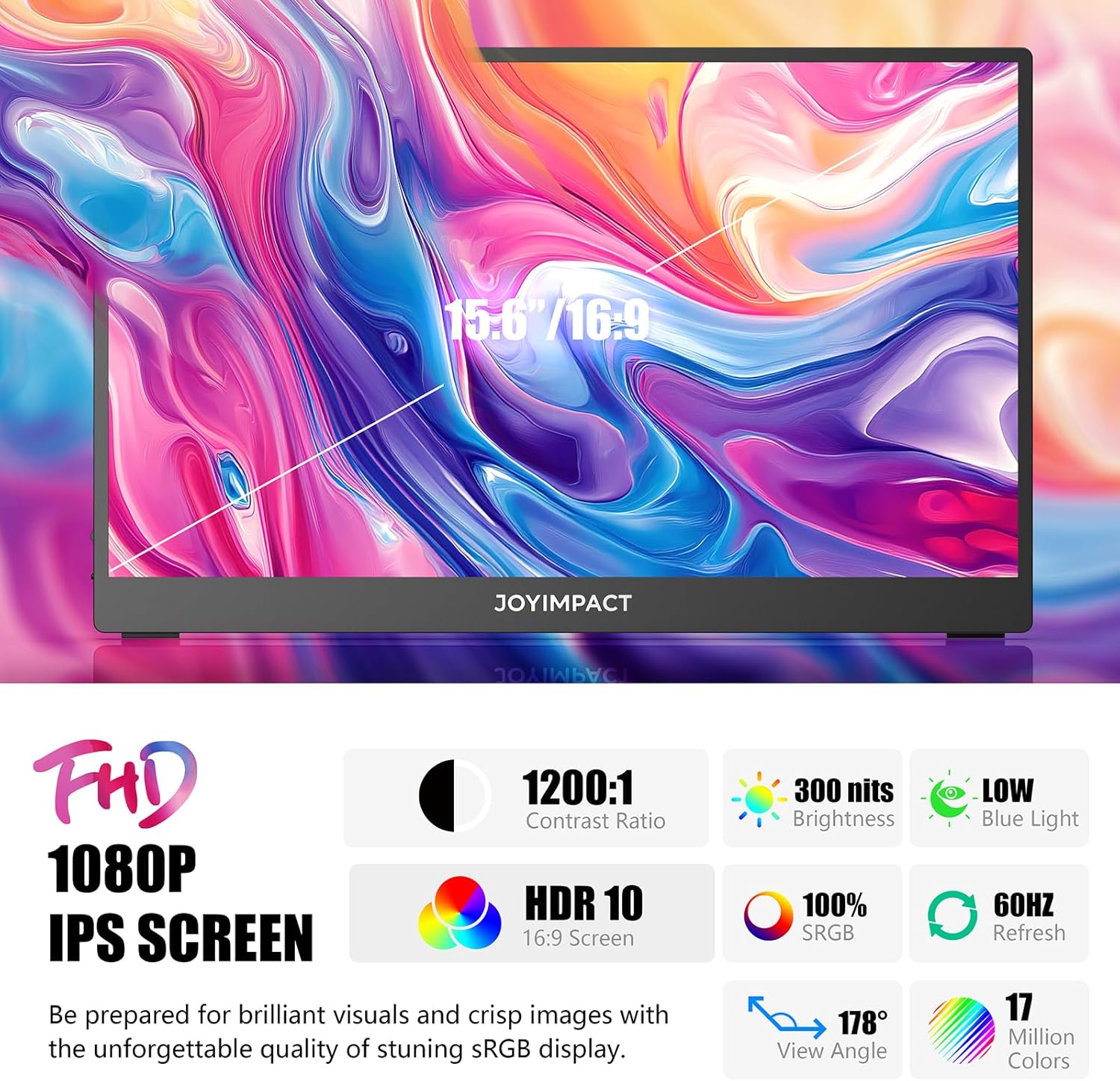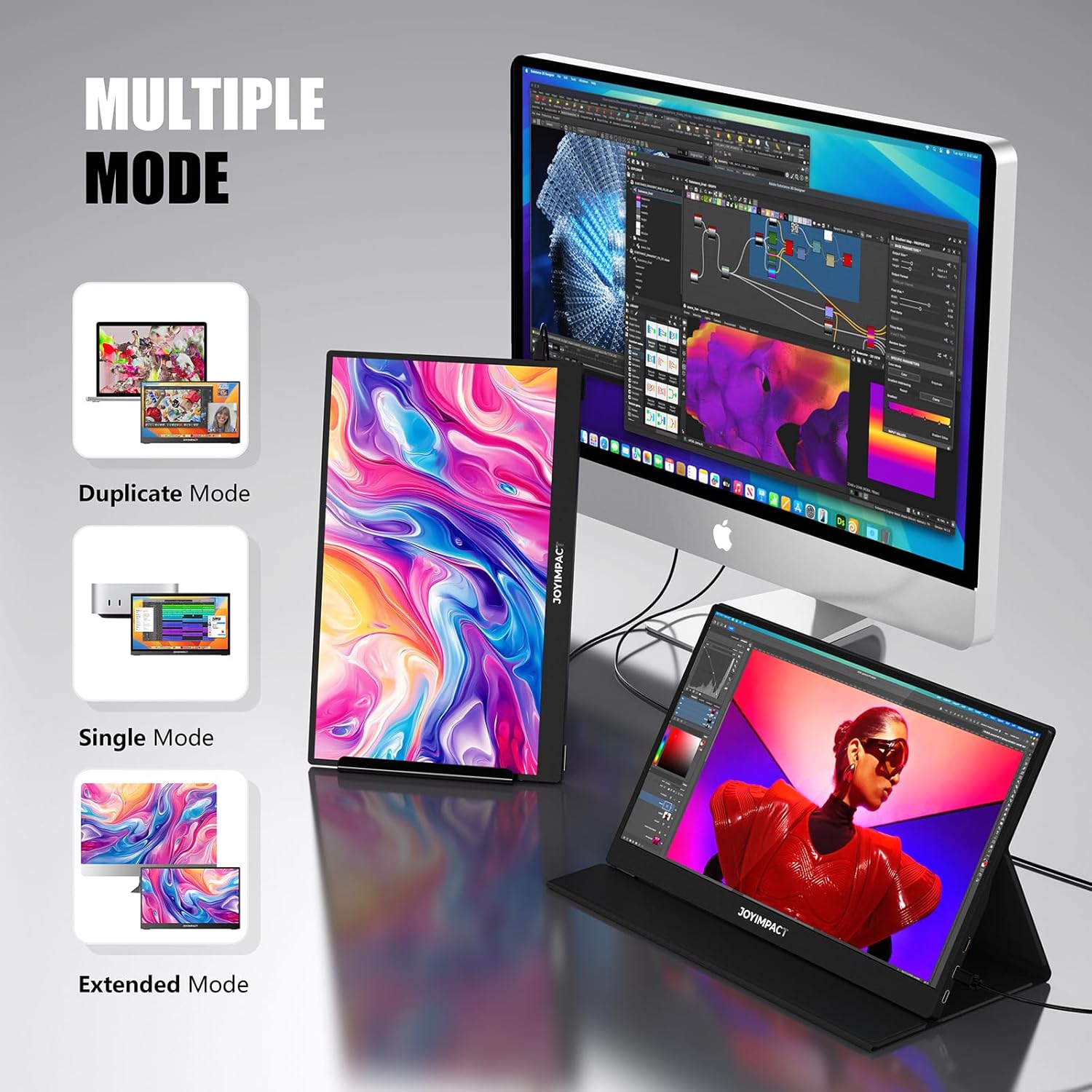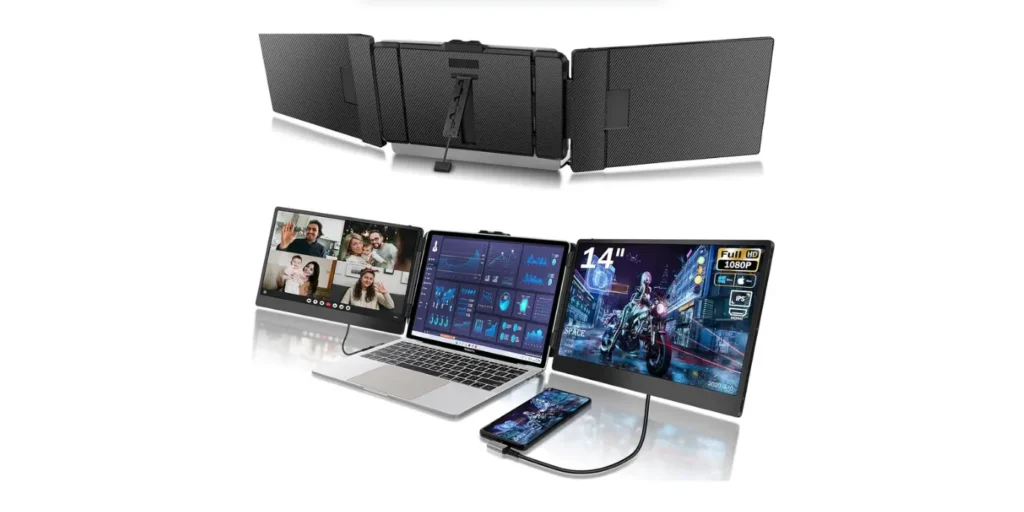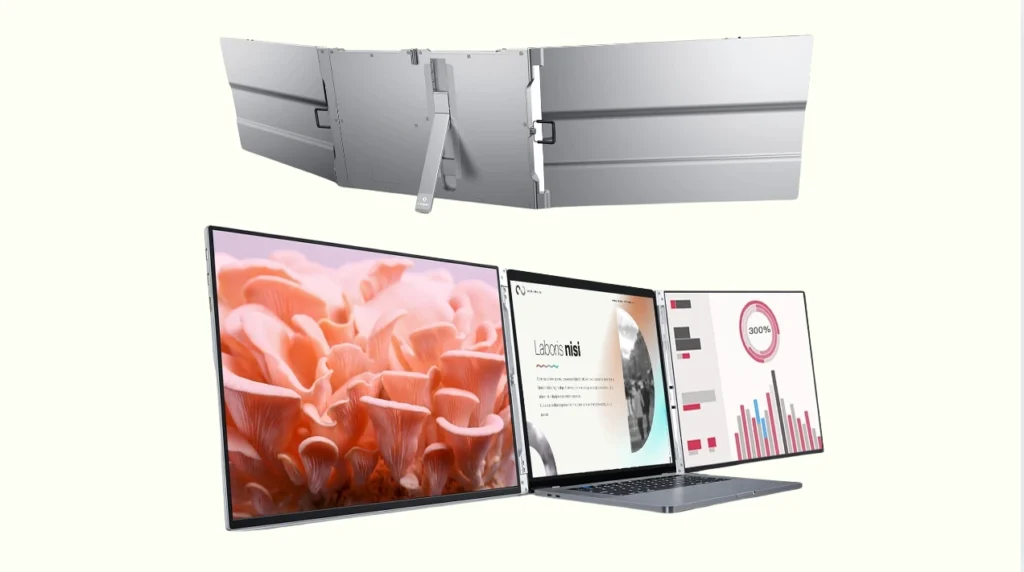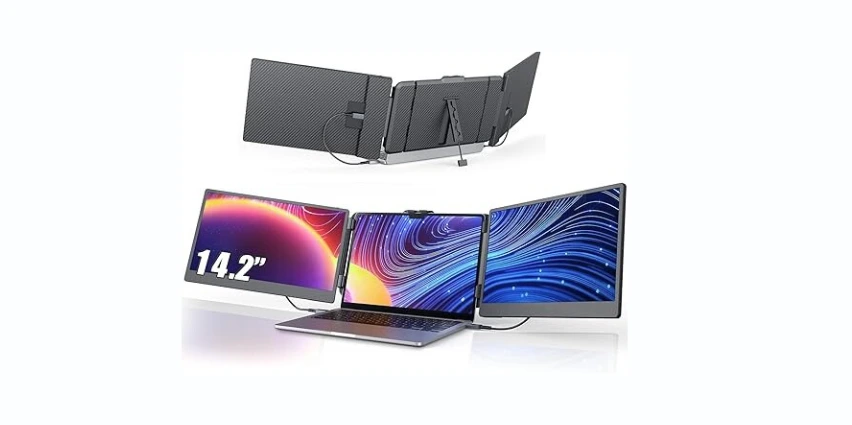Has a second screen ever saved your day, or at least salvaged your sanity?
Why We Wanted a Second Screen in the First Place
We’ve all tried living the minimalist laptop life: one screen, 13 to 15 inches of real estate, a dozen windows piled like a messy closet we promise we’ll clean. Then we meet our nemesis—deadline day with spreadsheets, slides, and Slack all asking for attention. That’s when the 15.6-inch JoyImpact laptop screen extender stops being a gadget and becomes a coping mechanism. It gives us extra space without committing to a hulking desktop setup, and it travels without judgment.
First Impressions Without the Drumroll
We opened the box expecting a practical slab and found something surprisingly polished. The “Laptop Screen Extender, 15.6″ IPS FHD 1080P Laptop Monitor Extender USBC HDMI Dual Speakers Portable Monitor for PC/Mac/Phone/PS5/PS4/Xbox/Switch, HDR Gaming Monitor with Cover Stand” (deep breath) arrives slim, tidy, and ready to work. There’s a confidence to devices that know exactly what they are; this one acts like a helpful coworker who doesn’t hog meeting time.
Design and Build Quality
There’s an elegance to hardware that feels like it will survive the inside of our bag. This portable external monitor uses an aluminum alloy bezel that resists flex and lends a premium touch. Weighing about 1.7 pounds with a 0.3-inch profile, it’s shockingly easy to slide into a backpack or briefcase without the ominous thunk of something we’ll regret carrying later.
Materials and Weight
We’ve carried lighter things, but not many that feel this sturdy. The aluminum frame lands in a sweet spot: thin enough to be portable, firm enough to inspire confidence. At 15.6 inches, it matches a typical laptop footprint, which helps when we prop it beside or behind our main machine on those crowded café tables where espresso and existential dread compete for dominance.
The Smart Cover That Earned Its Name
The included magnetic PU leather cover does double duty. It wraps the monitor for scratch protection and folds into a stand with two angle notches. Sometimes we want upright and formal, sometimes reclined and laidback; it obliges both. It’s also surprisingly good at preventing scuffs when the monitor jostles around next to our keys and whatever snack we swore was “for later” and definitely was not.
Ports and Button Placement
On the sides we get a full-featured USB-C port, a Type-C (DC IN) power port, and HDMI. Between them, connection choreography becomes simple: one cable from a modern laptop with USB-C DisplayPort Alt Mode, or HDMI for video plus a USB-C cable for power. Buttons are accessible and not the sort we accidentally press every time we reach for a cable.
Setup: From Zero to Two Screens in Minutes
If we had to choose a motto for this monitor, it would be: “Don’t overcomplicate it.” Setup is quick in the ways that matter. We choose our cable, plug in one or two ends, and watch the laptop politely say, “Ah yes, second screen, right away.” It’s the opposite of a software update; it just happens.
With Windows Laptops
The friendliest scenario is a laptop with a full-featured USB-C port. We connect a single USB-C cable and get video, audio, and power in one go, as long as the laptop can supply enough juice. Some laptops can’t, and that’s fine—plug the second Type-C cable into a wall adapter or power bank, and the screen wakes right up. If the laptop only has HDMI, we use the HDMI cable for video and a USB-C cable for power. Windows recognizes the display immediately; we head into Display Settings to extend, mirror, or adjust scaling.
With MacBooks and Macs
On a MacBook with Thunderbolt/USB-C, life is easy: a single cable and we’re in business. The macOS arrangement view lets us “drag” where the monitor sits relative to our laptop screen, which is oddly satisfying—like rearranging furniture without the bruised shins. If we’re on a desktop Mac, HDMI works fine too, with a second USB-C cable for power.
With Phones and Tablets
Some Android phones support desktop-style modes (we see you, Dex and friends) and connect through USB-C. It’s a strangely liberating feeling to turn a phone into a tiny workstation with a keyboard and mouse. For iPhones, we’d use an adapter to HDMI and then power via USB-C; once it’s up, streaming and watching become breezy.
With Consoles: PS5, PS4, Xbox, and Switch
We plug HDMI from the console to the monitor, and power the monitor via USB-C. The internal speakers fire up, and suddenly that quiet corner of a hotel room becomes a private game nook. For the Switch, it’s especially handy—whether docked or in handheld HDMI mode with the right adapter, we’ve got a crisp 1080p canvas.
Display Quality and Eye Comfort
This is where the portable monitor pulls above its weight class. The 15.6-inch IPS panel runs at Full HD (1920 x 1080) with an advertised 170-degree viewing angle, a 1200:1 contrast ratio, and a 16:9 aspect ratio. Translation: text looks clean, images are vivid, and we can move our head without playing guess-the-color-shift.
Resolution and Clarity
1080p at 15.6 inches remains a happy medium: dense enough for crisp fonts, friendly enough for long reading sessions without bumping system scaling to cartoonish levels. We can put Slack on the left, slides on the right, and still read everything without squinting like we’re trying to decode ancient inscriptions.
IPS Viewing Angles and Color
IPS panels remain the crowd-pleaser: wide angles, dependable consistency, and a calm approach to color. We can show someone a slide and not worry that what they’re seeing is a washed-out interpretation from a different universe. It’s not marketed as a color-critical reference display, but it’s more than good enough for photo edits, light video work, and presentations that don’t deserve the betrayal of a drab panel.
HDR Support in Practical Terms
HDR on a portable monitor can be a spectrum—from “oh, that’s a checkbox” to “this actually helps.” Here, HDR gives a noticeable lift in dynamic range when the content supports it. Shadows hold onto detail better; highlights pop without looking like a flashbang. It’s not the kind of HDR that will make cinephiles swear off their living-room TV, but on a portable screen, the improvement is real and easy to appreciate.
Blue Light Reduction and Flicker-Free Comfort
We’ve learned the hard way that our eyes are not replaceable at the corner store. This monitor includes blue-light reduction and flicker-free tech, which translates to less fatigue during marathon work sessions. It doesn’t mean we should stare unblinking for six hours, but it does mean we feel less fried after doing exactly that.
Sound: The Dual Speakers That Could
Built-in speakers are one of those features we don’t think about until we need them. The dual speakers here are perfectly serviceable for meetings, YouTube, podcasts, and light gaming. They won’t replace headphones or a dedicated soundbar, but they keep us from rummaging for earbuds when a call begins without warning. Voices are clear, and there’s enough volume to be heard over a coffee grinder if the barista is determined.
Productivity: Real Work, Less Window Tetris
If we were to assign a theme to this monitor, it would be “fewer tabs on top of each other.” Having a second screen creates a tangible sense of mental space, which might be the real magic trick. We keep email on one display, a document on the other, and our stress level somewhere in between.
Office and Meetings
During meetings, we keep the video conference on the JoyImpact and notes on our laptop. This makes us look attentive while actually being attentive. Spreadsheets breathe better when they’re not cramped, and presentations are easier to fine-tune when slides aren’t squeezed into oblivion. We also use portrait mode for long documents; it’s like discovering a secret hallway in a house you’ve lived in for years.
Coding and Creative Tasks
For coding, we keep the editor center stage and docs or logs on the side. The rhythm feels more natural; our eyes move left-right rather than up-down-up-down. For photo tweaks and basic design work, the IPS panel holds its own. We run a quick calibration using built-in OS tools and find the colors quietly pleasing. Not studio-grade, but decidedly trustworthy.
Gaming and Entertainment
Game nights become portable in a way we didn’t fully appreciate until we had this. Consoles plug in, the screen wakes without fuss, and the whole setup feels both casual and purposeful. The HDR boost helps in games with darker scenes, and the responsiveness feels in line with typical 60 Hz portable panels. We wouldn’t use it for hyper-competitive tournaments, but for story-driven games, platformers, and casual multiplayer, it’s perfectly at home.
Input Response and Motion
Portable monitors like this aim for smooth and consistent rather than blazing fast. That said, we don’t notice distracting latency in normal use, and motion looks clean enough for films and everyday gaming. It’s a pleasant, reliable experience—the kind we remember for not getting in the way.
Travel Streaming Setup
We’ve used it as a dedicated streaming screen: main laptop for editing, monitor for preview windows, chat, and audio meters. The dual speakers let us spot-check sound, while headphones remain our default for anything serious. It’s a nimble, compact rig that fits in a backpack and doesn’t scare airport security.
Portability: The Everyday Carry Test
If a gadget makes us reorganize our life to accommodate it, we quietly stop carrying it. This one passes the everyday carry test. At 0.3 inches thick and 1.7 pounds, it slots next to our laptop in the same sleeve. The smart cover prevents scuffs and the aluminum build shrugs off the minor indignities of commute life.
Durability and Daily Carry
The aluminum bezel feels reassuring. The cover folds neatly and magnetically holds position when used as a stand. We drop it onto tables with the casual confidence usually reserved for items that cost less than a latte, and it takes it in stride.
Portrait Mode Tricks
Rotate to portrait mode, and reading becomes civilized. Articles, PDFs, code, long chat threads—portrait is their natural habitat. We prop it vertically next to the laptop and suddenly feel like we own a newspaper office without the ink stains.
Power and Cables: What Actually Works Best
We appreciate clear expectations with power. This monitor supports a full-featured USB-C port, a Type-C (DC IN) power port, and HDMI. In practice, here’s how it shakes out:
- One-cable setup: If your laptop’s USB-C port supports DisplayPort Alt Mode and enough power delivery, a single USB-C cable can handle video and power.
- Two-cable setup: If your laptop’s USB-C doesn’t provide sufficient power—or you’re using HDMI—feed video via USB-C or HDMI and supply power via the Type-C (DC IN) port from a wall adapter or power bank.
- Consoles and phones: Generally HDMI for video (or USB-C for compatible phones), plus USB-C power to the monitor.
We keep a compact 20W USB-C charger in our bag, and it quietly solves most situations.
Power Etiquette: What Not to Expect
This is a monitor, not a hub. We don’t rely on it to charge our laptop. It’s happiest sipping its own power while our devices do their thing. The good news is that with a capable laptop port, we can still keep to a single cable; otherwise two cables are hardly a tragedy.
Compatibility Quick Guide
We like having a simple reference when we’re packing for a trip. Here’s how we mentally map our connections:
| Device/Source | Preferred Connection | Power to Monitor Needed? | Notes |
|---|---|---|---|
| Modern Windows laptop (USB-C DP Alt Mode) | Single USB-C cable | Maybe | If laptop port supplies enough power, one cable works; otherwise add USB-C power. |
| Windows laptop (HDMI only) | HDMI for video + USB-C for power | Yes | Simple and reliable. |
| MacBook with USB-C/Thunderbolt | Single USB-C cable | Maybe | Often works with one cable; add power if needed. |
| Desktop Mac (HDMI available) | HDMI + USB-C for power | Yes | Straightforward setup. |
| Android phone with desktop mode (USB-C DP Alt Mode) | Single USB-C cable | Usually | Some phones power the monitor briefly; a separate power cable is more stable. |
| iPhone (via adapter) | HDMI adapter + USB-C for power | Yes | Video through adapter, monitor powered separately. |
| PS5/PS4/Xbox | HDMI + USB-C for power | Yes | Plug-and-play for gaming. |
| Nintendo Switch (docked or HDMI adapter) | HDMI + USB-C for power | Yes | Great for portable gaming. |
We try to keep one USB-C to USB-C cable, one USB-C power adapter, and one HDMI cable in the same pouch. It’s the tech equivalent of carrying breath mints: appreciated by all.
Feature Rundown at a Glance
Sometimes we want to see the essentials in a single glance. This helps us check off needs without turning shopping into homework.
| Feature | What We Get | Why It Matters |
|---|---|---|
| Screen Size | 15.6 inches | Balances portability and usable space. |
| Resolution | 1920 x 1080 (FHD) | Crisp text and video without scaling drama. |
| Panel Type | IPS | Wide viewing angles, consistent color. |
| Contrast Ratio | 1200:1 | Satisfying depth for movies and photos. |
| Aspect Ratio | 16:9 | Natural for video, presentations, and most apps. |
| HDR | Supported | Boosts highlights and shadow detail for HDR content. |
| Speakers | Dual built-in | Handy for meetings and casual media. |
| Ports | USB-C (full-featured), USB-C (DC IN), HDMI | Flexible for laptops, phones, and consoles. |
| Weight | ~1.7 lbs | Easy to carry daily. |
| Thickness | ~0.3 inches | Slides into any bag without a fuss. |
| Cover | Magnetic PU smart cover/stand | Protects and props with two angles. |
| Viewing Angle | ~170° | Shareable and comfortable off-axis. |
| Eye Care | Blue-light reduction, flicker-free | Better for long work sessions. |
| Warranty | 12 months (except external damage) + 30-day returns | Practical peace of mind. |
Tips, Tweaks, and Troubleshooting
We like devices that work out of the box. Still, a few simple tweaks make good better.
Common Issues and Quick Fixes
- No signal via USB-C: Check that the laptop’s USB-C supports DisplayPort Alt Mode; if not, use HDMI. Try flipping the cable; some are directional.
- Screen flickers or turns off: The monitor may be underpowered. Add a dedicated USB-C power adapter to the Type-C (DC IN) port.
- Audio not coming through: In OS sound settings, choose the monitor as the output device. Then turn the monitor volume up using its side buttons.
- Colors look off: Set the monitor’s color profile in your OS and choose a neutral or sRGB-like profile. Adjust brightness and contrast modestly.
- Portrait mode feels weird: In display settings, rotate to “portrait” and reposition the virtual layout so cursor travel feels natural.
Calibration Without the Drama
We open the OS display calibration tool, set brightness for comfortable viewing, and choose a neutral color temperature. We avoid fancy tweaks unless we’re editing photos, and even then, we keep it sensible. Lower blue-light settings in the evening help keep sleep on speaking terms with us.
Everyday Scenarios Where It Shines
If there’s one word we keep returning to, it’s “useful.” This monitor doesn’t demand rituals or new habits; it simply makes a meaningful difference in how we work and unwind.
- Airport layover office: Laptop on one side, email and docs on the other, the illusion of productivity made real.
- Hotel desk theater: Stream on the JoyImpact, laptop free for messages and planning.
- Kitchen counter: Recipe full-screen while we pretend we’re the kind of people who measure.
- Shared workspace: Present a slide deck on the portable monitor while our laptop keeps the notes out of sight.
- Train table coding: Terminal logs on one display, code editor on the other—a sense of order we rarely feel internally.
The JoyImpact Smart Cover in Daily Life
We underrate good covers until we meet a bad one. This one folds intuitively, holds its angles, and shields the panel from scratches. The two notches for angle adjustment are simple and predictable. It’s a quiet design that does exactly what it’s supposed to do—protect and prop—without calling attention to itself.
How It Travels
A portable monitor must pass the travel test, not just the coffee shop cameo. We’ve slipped this into backpacks and messenger bags, wedged it between sweaters and cables, and generally treated it like something we paid less for. It’s still here, aluminum edges unmarred, screen unscathed. Combined with the cover, it tolerates the bumps and shuffles of buses, planes, and the eternal shuffle between rooms at home.
Who It’s For (and Who Might Skip)
We’ve learned that one device can be perfect for us and not right for our cousin who edits cinema-grade footage in a cave.
-
Ideal for:
- Remote workers who want a simple second screen that travels.
- Students juggling research, video lectures, and notes.
- Presenters who need a clean way to mirror without commandeering room equipment.
- Casual gamers who want console flexibility on the go.
- Anyone who stares at spreadsheets and questions life choices.
-
Maybe not for:
- Color-critical professionals who need calibrated, high-end panels with exacting specs.
- Competitive gamers who prioritize ultra-high refresh rates and the lowest latency possible.
- People who never leave their desk and already own a large, permanent monitor.
The Two-Cable Scenario Nobody Talks About
We notice that many portable monitor setups become unexpectedly elegant with two cables: one for video (USB-C or HDMI), and one for power. This is the most reliable arrangement across different devices and saves us from unpredictable power draw debates. A tiny USB-C charger, a short HDMI cord, and we stop thinking about it.
Using It as a Presentation Companion
Instead of hunting for a room’s HDMI cable or dealing with a projector that insists on 1024×768 like it’s 2006, we line up this monitor on the table and present right there. Our audience can sit close, take notes, and avoid the ritual of fiddling with inputs. It’s strangely intimate in the good way—like a collaborative session rather than a broadcast.
What Surprised Us Most
We knew we’d like the extra real estate. We didn’t expect how much calmer we’d feel with two screens, even when the tasks stayed the same. There’s a small thrill in rotating to portrait for reading or debugging. And we appreciate that the HDR toggle actually enhances movies and games rather than merely changing the contrast to “dramatic.”
The Warranty Safety Net
JoyImpact’s after-sales promise—a 30-day return policy and 12-month warranty (excluding external damage), plus a commitment to respond within 12 hours—packs more reassurance than we usually expect from a portable display. If we get stuck or something seems off, we feel like we’re not shouting into the void.
Pros and Cons, Honestly
We prefer laying the cards on the table—cards with rounded corners and tasteful typography.
-
What we love:
- Respectably bright and sharp FHD IPS panel with wide viewing angles.
- Lightweight, sturdy build with an aluminum alloy frame.
- Smart cover that actually works and protects.
- Flexible connectivity: full-featured USB-C and HDMI.
- HDR that adds real-world punch to compatible content.
- Dual speakers for meetings and casual viewing.
- Easy setup across laptops, phones, and consoles.
- Eye comfort features that matter in long sessions.
-
What we’d improve:
- We’d love clearer labeling around one-cable power support across different laptops (not JoyImpact’s fault entirely; the USB-C ecosystem is a maze).
- Speakers are fine, but we still prefer headphones or external speakers for movies and music.
- No mention of a built-in battery; plan on powering it in most scenarios.
- Color is pleasing but not tuned for critical grading out of the box.
A Few Smart Habits We’ve Picked Up
- Keep a tiny cable kit: USB-C to USB-C, HDMI to HDMI, and a 20W USB-C charger. Suddenly everything works everywhere.
- For long reading, rotate to portrait and slightly lower brightness. Our eyes appreciate the spa day.
- On Windows, set text scaling to 100–125% depending on distance; on macOS, pick “More Space” if you like dense layouts.
- Use the monitor speakers for calls and keep headphones ready for everything personal. Our neighbors don’t need to hear our show choices.
Our Ideal Use Cases, Ranked by How Much We Smile
- Document + reference: Laptop for writing, JoyImpact for research tabs, PDFs, and chats. A small but mighty sanity upgrade.
- Travel gaming corner: HDMI from console or Switch, USB-C power, and suddenly we’ve invented “vacation arcade.”
- Photo culling: Full-screen grid on the portable monitor, develop module on the laptop. Our shoulders unclench.
- Meetings with notes: Presentation on one, speaker notes on the other, like that time we almost looked prepared and actually were.
- Kitchen assistant: Recipe on the monitor, music on the laptop. The onions still make us cry, but for different reasons.
Where It Fits in Our Tech Stack
We think of the JoyImpact as the capsule wardrobe piece of displays—works with everything, dresses up or down, never feels fussy. It complements our laptop, supplements our desktop in a pinch, and stands in for a TV when space is tight. It behaves like an adult in a world of gadgets that often need supervision.
Longevity and Daily Reliability
After extended use, what stands out is the absence of drama. No peculiar quirks, no mysterious disconnects, no tantrums when switching devices. The hinge-free, folio-stand setup means fewer moving parts. The screen surface resists fingerprints well enough that we don’t carry a microfiber cloth like a sommelier.
The JoyImpact Difference, Summed Up
If we had to distill it: this is a monitor that shows up, plugs in, and does the job with quiet competence. It’s not a diva about power. It doesn’t require special drivers. It fits in our bag and our life. We attach it and wonder why we ever thought one screen was enough.
The Fine Print That Matters
- Resolution: 1920 x 1080, IPS panel, 16:9.
- Claimed contrast: 1200:1; viewing angle: 170°.
- HDR support is present and perceptible with appropriate content.
- Ports: full-featured USB-C, Type-C (DC IN), HDMI.
- Weight: around 1.7 lbs; thickness: roughly 0.3 inches.
- Included smart cover doubles as a stand with two adjustable notches.
- Dual speakers built-in.
- Blue-light reduction and flicker-free operation listed.
- Compatible with PC, Mac, phones, PS5/PS4, Xbox, Switch—essentially anything that can talk HDMI or USB-C video.
- Warranty: 12 months (except external damage), 30-day returns, and responsive support that aims for a 12-hour turnaround.
We like accuracy as much as we like snacks, so we’ll add this: USB-C behavior can vary by device. If your laptop’s USB-C port doesn’t supply enough power, or if you’re using HDMI, factor in the extra USB-C power cable. That’s not a flaw so much as the reality of the modern cable jungle.
Our Verdict After Living With It
We’ve come to expect portable monitors to compromise somewhere: flimsy stands, fussy connections, questionable panels. The JoyImpact model dodges those pitfalls with thoughtful design, consistent performance, and a feature set that reads like a helpful checklist rather than a sales pitch. It’s thin and tough, sharp and friendly, with honest HDR and speakers that get the job done. The magnetic cover works like a charm, and the cross-device compatibility feels mature.
If a two-screen life sounds like a luxury, we’d argue it’s more like ergonomic kindness. This monitor doesn’t just add pixels; it adds room to think. For commuters, students, remote workers, and travelers, it’s the tidy, portable desk extension we didn’t know we needed until we used it once and then had to apologize to our single-screen past.
Should We Buy It?
If our checklist includes portability, 1080p IPS quality, flexible ports, HDR for a bit of flair, and a cover that doubles as a capable stand, then yes—we’re squarely in “buy” territory. It’s reasonably light, cleverly designed, and admirably compatible. Add the warranty and the responsive support promise, and the value proposition gets even friendlier.
In a world where screens compete for attention, this one quietly earns it. We pack it, we use it, and we get work done with a little more grace. Then, when the workday ends, we plug in a console and remember the other reason we bought it: sometimes the best productivity hack is knowing when to play.
Disclosure: As an Amazon Associate, I earn from qualifying purchases.



